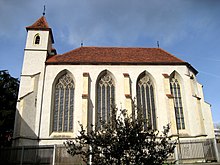Leechkirche
The Leechkirche , actually Maria Himmelfahrt am Leech, is the oldest Roman Catholic church in Graz . It is somewhat hidden on a hill in the Geidorf district and is accessible from both Zinzendorfgasse and (via Rittergasse) from Glacisstraße. It forms the Kuratbenefizium Graz-Leechkirche the Graz cathedral parish in the deanery Graz center of the town church Graz .
history
The place where today's Leechkirche is located was part of a burial ground of the urn field culture from the 9th and 8th centuries BC. From the 6th century BC A Hallstatt burial mound with a diameter of about 20 meters comes from the 4th century BC . However, grave goods were not found due to grave looting. In the absence of in-situ finds from the Celtic and Roman times, no cult continuity is assumed. The naming - Leech comes from the Old High German hleo , hill grave - suggests that until the end of the 1st millennium AD, knowledge of the function of the hill was preserved without being overlaid by subsequent use. The barrow still leaves a trace in the current cadastre: The property is - apart from a few roundabouts - the only round one in the city of Graz. The retaining wall made of smoothed large boulders on the edge of the plateau with the church traces this basic boundary to this day.
Around the year 1000 AD, a first round building (without apse ) was built, in the foundation of which Roman roof tiles (tegulae) were found. This suggests that there was a (not yet localized) Roman building in the vicinity, the remains of which have been reused. In 1202, Duke Leopold VI. replace this first church building with the St. Kunigunden chapel (also a round church, this time with an apse). The first documentary mention is in connection with a court that the duke held at this point in 1224. The late Romanesque church hill, which is significantly larger in size than the original burial mound, and on which the current church stands, is likely to come from this time. In 1233, Duke Friedrich II of Austria and Styria donated the church area to the Teutonic Knight Order . Probably in the year 1250 the Kunigunden chapel was destroyed, whether through natural or armed events remains unclear.
Construction began in 1255, and today's church was actually built in 1275–1293 in the early Gothic style . Based on the reliquary seal , it could be proven that this church was consecrated in 1293 by the then Bishop of Gurk , Hartnid von Lichtenstein-Offenberg . The German Order of Knights was granted the right of asylum in the area around the church . Although the Teutonic Order had no right of burial (apart from that of its own members), dozens of graves of non-members of the order were found under today's church.
The Leech Church was given in 1979 by the Teutonic Order of the Diocese of Graz-Seckau , which designated it as the university church for the nearby Karl-Franzens University of Graz in 1985 . In the years 1991–1994 it was thoroughly renovated and re-consecrated on April 30, 1994.
construction
The early Gothic tympanum Madonna with the child above the portal on the west side was made around 1290. Inside the church, the same artist designed the keystones of the vault; these represent a branch crucifix, St. Kunigunde, St. Margaret and St. Barbara. The high altar from around 1780 contains a carved wooden statue of the Virgin Mary from the 15th century. The statue of Mary is flanked by statues of Saint Kunigunde and Saint Elisabeth. To the left of the high altar is a Gothic sacrament niche from 1499 in the apse wall. A painted Pietà is in a niche to the right of the altar. The stained glass dates from the 14th to 15th centuries. The towers are younger than the rest of the church and date from around 1500. The floor plan of the Leopoldine Kunigunden chapel is milled into the modern floor of today's church in the form of a thin line.
literature
- Alois Kölbl, Wiltraud Resch: Paths to God. The churches and synagogue of Graz. 2nd, expanded and supplemented edition. Styria, Graz 2004, ISBN 3-222-13105-8 , pp. 126-129.
- Horst Adler (Ed.): Research on the Leech Church in Graz (= Fund reports from Austria. Materialhefte. A 4). Verlag Berger, Horn 1996, ISBN 3-85028-278-3 .
Individual evidence
- ↑ Speech by the Rector of the Leechkirche during the bike ride to community gardens of the Green Academy and Forum Stadtpark on June 9, 2013
Web links
Coordinates: 47 ° 4 ′ 32 " N , 15 ° 26 ′ 48" E




